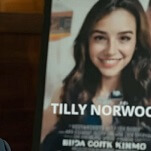The lines separating various comics niches have gotten fuzzier every year, as genre comics become more literary, literary comics incorporate more reportage and autobiography, and the highest-profile projects of any given season include the archiving and annotating of material that used to disappear into flea markets and quarter boxes. So the artier side of The A.V. Club’s 2012 best-comics list will be reducing to three the tangle of categories from years past: one category for fiction (original graphic novels, collections of formerly serialized material, short-story anthologies, and substantial chapters of ongoing stories), one for non-fiction (memoirs, histories, travelogues, journalism, and criticism), and one for archival collections (focusing on archival series that launched this year, rather than such essential ongoing series as Little Orphan Annie, Pogo, Floyd Gottfredson’s Mickey Mouse newspaper strip, and The Carl Barks Library).
Top 10 Fiction
1. Chris Ware, Building Stories (Pantheon)
Packaged in a box the size of a board game, and divided among 14 different books, tabloid sheets, and pamphlets, Ware’s Building Stories can seem initially imposing, with its “read in any order you like” non-structure and assortment of typically morose Ware protagonists. But as Ware tracks these characters—an old landlady who’s never known romance, a bickering young couple who used to be hip, an easily distracted bumblebee, and an insecure artist with a prosthetic leg—the way the author empowers the readers to make their own connections transforms the work. Take certain passages out of the context, and Building Stories can seem like a cruel dissection of miserable people who just keep failing; read in full, there are moments of hope and comedy that give the despair meaning.
2. Michel Rabagliati, The Song Of Roland (Conundrum/BDANG)
Michel Rabagliati’s previous “Paul” books have dealt with growing up, going to school, getting a job, finding a mate, and having a child. Rabagliati’s The Song Of Roland is about losing a parent, as Paul’s father-in-law slowly succumbs to cancer. But The Song Of Roland is also about the smaller changes in Paul’s life, and how it can all slip past too quickly unless someone is around to recollect it.
3. Darwyn Cooke, Parker: The Score (IDW)
As with 2010’s The Outfit, The Score adapts one of Donald Westlake’s terse, tough Parker novels, with Darwyn Cooke expertly rendering both its nifty plot and its understanding of a sociopathic antihero. In The Score, Parker heads up the heist of a small mining town, allowing Cooke to map out both the job and its driven, joyless mastermind. This is first-rate crime fiction and stellar graphic design, in one potent package.
4. Jeff Lemire, The Underwater Welder (Top Shelf)
Jeff Lemire’s graphic novels blend accessibility and visual poetry, in stories about broken people with painful pasts. The Underwater Welder is about a young father-to-be who worries about what kind of legacy he’s going to pass on to a son who’s due to arrive whether his dad is emotionally ready or not. Lemire’s words are sometimes inelegant, but his pictures express what’s beneath those words, plumbing the depths of parental anxiety.
5. Jason, Athos In America (Fantagraphics)
In Jason’s latest short-story collection, a musketeer relates an anecdote about a disastrous Hollywood romance, a scientist has a love affair with a disembodied head, villains deal with their anxiety over being pursued by a superhero, and many more of Jason’s blank-faced animal-headed characters reveal unexpectedly deep passion via deadpan tales of dislocation.
6. Ed Piskor, Wizzywig: Portrait Of A Serial Hacker (Top Shelf)
Compositing and fictionalizing the real-life anecdotes of tech outlaws, Ed Piskor’s Wizzywig evokes empathy for the put-upon people who use computers to pull pranks on their oppressors. Wizzywig is full of fascinating, well-researched tidbits about how hackers run their scams, but Piskor never loses sight of why social misfits become criminals, or how crafty deviants can serve to keep both governments and corporations in check.
7. Lilli Carré, Heads Or Tails (Fantagraphics)
Lilli Carré’s stories are like dreamy what-ifs that take the familiar and tweak it. What if an art critic lost his sense of discernment? What if a queasy young man met a single mother at rural carnival? Rendered in Carré’s eclectic, experimental styles, these pieces have a quality not unlike the kind of whimsical animated shorts that pop up at film festivals, yet they’re unified by their sense of life’s endless possibility.
8. Charles Burns, The Hive (Pantheon)
The Hive continues the story Charles Burns began in X’ed Out, about a performance artist who reflects on his hazy past while stuck in a twisted hellscape. Burns fuses the sensibilities of the late-’70s New York punk and art scenes with fragments of pulp comics and old movies, working with thick lines to draw an oozing world of nightmarishly misshapen creatures. As with Burns’ dark masterpiece Black Hole, this trilogy-in-the-making targets the recognizable human emotions within a bad, bad dream.
9. Tom Gauld, Goliath (Drawn & Quarterly)
Tom Gauld’s Goliath is his fullest piece yet: a recounting of the Biblical tale of David and Goliath from the point of view of the giant, who’s a reluctant soldier. Gauld keeps his dialogue to a minimum and his page/panel designs open, working with cartoony figures, silhouettes, and finely cross-hatched close-ups to tell a story about how public perception creates reality.
10. Brecht Evens, The Making Of (Drawn & Quarterly)
Brecht Evens’ The Making Of follows an arrogant artist named Peterson to a small-town arts festival, where he discovers that he’s stranded among eccentrics and hobbyists. It’s a funny book with rich characters, matching keen insights into human relationships with beautiful and innovative illustrations, all in service of a study of a man who manipulates others to get what he wants—as any true artist does.
Top 10 Non-Fiction
1. Derf Backderf, My Friend Dahmer (Abrams ComicArts)
Serial killer Jeffrey Dahmer was a classmate of cartoonist John “Derf” Backderf in junior high and high school in a small town in Ohio. My Friend Dahmer describes how Derf and his buddies became “fans” of Dahmer’s quirky behavior, though none of them knew what Dahmer was up to when he returned to his broken home. Derf chillingly illustrates the superficiality of most high-school relationships, where the people involved are so absorbed in their own lives that they fail to see the desperate characters who dwell among them.
2. Joe Sacco, Journalism (Metropolitan/Henry Holt)
Joe Sacco has made a career out of listening to the powerless and then turning their stories into comics reportage that strives to be at once personal and fair. The value of Sacco’s approach is on full display in Journalism, a collection of shorter pieces that reveals the human side of the struggles in places like the Gaza strip, Iraq, and India. Beyond being a superior cartoonist—able to capture how the world actually looks and imbue it with his own skewed impressions—Sacco is a quality newshound.
3. Guy Delisle, Jerusalem: Chronicles From The Holy City (Drawn & Quarterly)
The fourth of French-Canadian cartoonist Guy Delisle’s comics travelogues brings his wry point-of-view to bear on both the huge injustices and tiny inconveniences of life in a divided Israel. Using his typical diary style—rendered with small, cartoony figures set against fairly realistic landscapes—Delisle and his colorist Lucie Firoud depict Jerusalem as a city constantly on edge, where longtime residents keep on living ordinary lives amid uncommon strife.
4. Harvey Pekar and JT Waldman, Not The Israel My Parents Promised Me (Hill & Wang/FSW)
Harvey Pekar’s latest posthumous project is a collaboration with artist JT Waldman, structured like a long conversation taking place over the course of one day in Cleveland, in which the two men explore the origins and consequences of Zionism. Not The Israel My Parents Promised Me jumps back and forth between a concise history of the Jewish people and Pekar and Waldman’s own evolving views, peering past the powerful’s view of history to get the viewpoint of the common man—as was Pekar’s wont.
5. Rick Geary, Lovers’ Lane: The Hall-Mills Mystery (NBM/ComicsLit)
Rick Geary’s latest “Treasury Of XXth Century Murder” tackles what at one time was one of the most famous crimes of the century, in which an Episcopalian minister was found dead alongside a member of his choir, surrounded by love letters. The case dragged on for nearly five years, covered with maximum hyperbole by the cutthroat New York papers. Geary focuses on the citizens of the small town where the crime took place, using his detached style to get at how people live side-by-side with scandal, right up to the day it erupts into violence.
6. Alison Bechdel, Are You My Mother? A Comic Drama (Houghton Mifflin Harcourt)
Alison Bechdel’s follow-up to her memoir Fun Home reads like an extended footnote to that bestseller, meant to answer the question, “What does your mother think of all this?” Bechdel wrestles with her complicated relationships with her psychotherapists and lovers as well as her mom, trying to be honest about how growing up with a chilly parent affected her life in subtle ways. Are You My Mother? fills in some of the big gaps in Fun Home, and is formally exciting to boot.
7. Michael Goodwin and Dan E. Burr, Economix: How And Why Our Economy Works (And Doesn’t Work) In Words And Pictures (Abrams ComicArts)
Taking an accessible approach to a dense subject, writer Michael Goodwin and artist Dan E. Burr’s Economix touches on all the major economic theories as a way of explaining how the global economy became so dysfunctional. The book has a clear and undisguised agenda, but also a cogent argument to make, and it helps both that Goodwin is so comprehensive and that Burr’s cartooning is in the spirit of other great explanatory comics artists, like Scott McCloud and Larry Gonick.
8. Philippe Ôtié and Li Kunwu, A Chinese Life (SelfMadeHero)
Philippe Ôtié’s Western-oriented comics storytelling helps give structure to Li Kunwu’s memoir A Chinese Life, which filters a nation’s last six decades of history through personal anecdotes. Born in 1955 as the son of a Communist Party official, Li was raised to believe that China was at the forefront of a glorious, worldwide proletariat revolution; and then China began to liberalize, forcing Li to adjust again. A Chinese Life explains what it’s like to be born into circumstances so unusual that every bizarre turn the culture took felt normal.
9. Frank M. Young and David Lasky, The Carter Family: Don’t Forget This Song (Abrams ComicArts)
Writer Frank M. Young and artist David Lasky’s comics biography The Carter Family: Don’t Forget This Song divides the lives of the country-music pioneers into short vignettes, like a series of songs revolving around a single theme. Lasky’s art splits the difference between family-album portraiture and the Sunday funnies, turning the Carters into characters in a sprawling, Little Orphan Annie-like soap opera, complete with marital squabbles, financial woes, unscrupulous businessmen, and plucky perseverance.
10. Alvin Buenaventura, Modern Cartoonist: The Art Of Daniel Clowes (Abrams ComicArts)
The Alvin Buenaventura-edited coffee-table book Modern Cartoonist contains a lengthy Daniel Clowes interview alongside essays and appreciations, all illustrated with copious samples of Clowes’ work. The text-pieces are well-chosen and give a sense of where Clowes fits into the larger worlds of fine arts, cinema, and literature. Modern Cartoonist recognizes and analyzes what Clowes has done to become such a significant figure in the history of the medium, explaining how he uses the frame of a comics panel to convey perspective, all while constructing narratives that pull readers easily along—then pull the rug out from under them.
Top 5 Archival Collections
1. Harvey Kurtzman, Corpse On The Imjin! And Other Stories (Fantagraphics)
EC Comics’ output of crime, horror, and war comics have been reprinted and collected multiple times, but never like in Fantagraphics’ new “EC Comics Library,” which repackages some of the most influential comics ever published in writer/artist-driven volumes, printed in black and white. The first two books are Came The Dawn And Other Stories Illustrated By Wallace Wood and Corpse On The Imjin! And Other Stories By Harvey Kurtzman, and while both are terrific, the Kurtzman book is especially stunning, almost like a coffee-table art-book combined with a literary collection. Corpse On The Imjin! brings together all of the Kurtzman-drawn war stories, along with a dozen more that he wrote and laid out for artists like Wally Wood, Jack Davis, John Severin, and Alex Toth. The result is an anthology with a strong individual perspective that tries to tell the truth about what war is like from the point of view of the people on both sides of the battlefield.
2. Otto Soglow, Cartoon Monarch: Otto Soglow & The Little King (IDW/The Library Of American Comics)
Originally a political cartoonist who favored rough crayon lines and working-class anger, Otto Soglow cleaned up his art and softened his humor when he created The Little King: a short, rotund, bearded ruler who silently pines for the fun that his subjects seem to be having. The Little King ran as newspaper strip from the ’30s until 1975, and Cartoon Monarch selects some of the best of those strips, all of which show how with only a few lines, Soglow could draw readers into a cockeyed realm, at once grand and banal.
3. Dick Moores, Gasoline Alley: Daily Comics 1964/1966 (IDW/The Library of American Comics)
In 1960, Gasoline Alley creator Frank King started giving his longtime assistant Dick Moores primary control of writing and drawing the strip, and in 1964, King finally allowed Moores to sign his own name. Moores’ art was more curvy and thick-lined than King’s, and he focused more on some of the strip’s minor characters; but the tone remained the same, with old-fashioned melodrama mixed with light character comedy and the occasional bit of slapstick, as Moores extended King’s original idea of tracking the small changes in one family across decades.
4. Milt Caniff, The Complete Steve Canyon Volume 1: 1947-1948 (IDW/The Library Of American Comics)
In 1946, “Rembrandt Of The Comic-Strips” Milton Caniff walked away from Terry And The Pirates, one of the most popular strips in the newspaper business, and launched a new creator-owned feature. After 10-plus years of Terry, Caniff knew how to tell stories about globetrotting adventurers, so unlike a lot of the recent batch of vintage newspaper comics collections, The Complete Steve Canyon presents a strip that was fully formed right from the start, relating the saga of a rugged pilot-for-hire that millions of readers were keen to love even before the first panel appeared.
5. Ernie Bushmiller, Nancy Is Happy: Complete Dailies 1943-45/Nancy Likes Christmas: Complete Dailies 1946-48 (Fantagraphics)
Fantagraphics’ archival collections of the Nancy newspaper strip join Ernie Bushmiller’s magnum opus in full swing, skipping past the formative years to 1943, when Bushmiller had his shtick down. In strip after strip, bristle-headed Nancy and poor slob Sluggo inadvertently irritate the grown-ups in their lives, in scenarios that Bushmiller illustrated with absurd visual gags—so basic that anyone, anywhere, at any time, could get the joke.






































